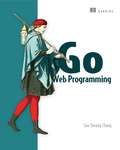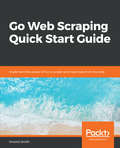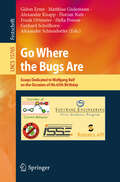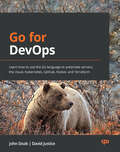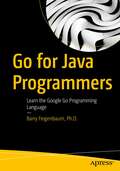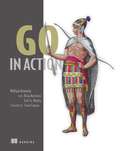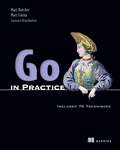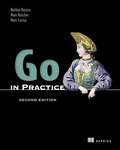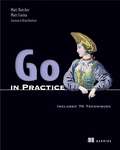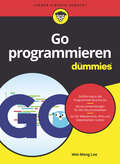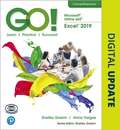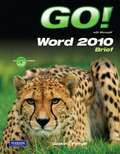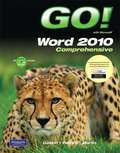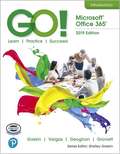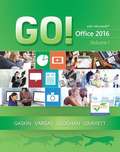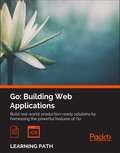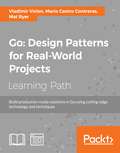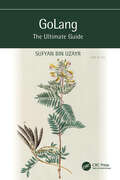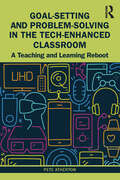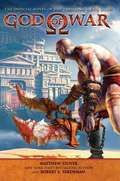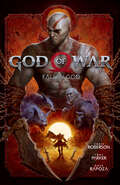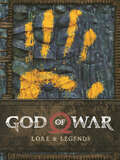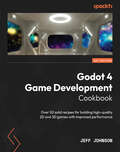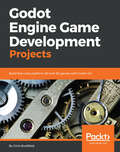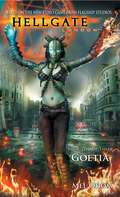- Table View
- List View
Go Web Programming
by Sau Sheong ChangSummaryGo Web Programming teaches you how to build scalable, high-performance web applications in Go using modern design principles.Purchase of the print book includes a free eBook in PDF, Kindle, and ePub formats from Manning Publications.About the TechnologyThe Go language handles the demands of scalable, high-performance web applications by providing clean and fast compiled code, garbage collection, a simple concurrency model, and a fantastic standard library. It's perfect for writing microservices or building scalable, maintainable systems.About the BookGo Web Programming teaches you how to build web applications in Go using modern design principles. You'll learn how to implement the dependency injection design pattern for writing test doubles, use concurrency in web applications, and create and consume JSON and XML in web services. Along the way, you'll discover how to minimize your dependence on external frameworks, and you'll pick up valuable productivity techniques for testing and deploying your applications.What's InsideBasicsTesting and benchmarkingUsing concurrencyDeploying to standalone servers, PaaS, and DockerDozens of tips, tricks, and techniquesAbout the ReaderThis book assumes you're familiar with Go language basics and the general concepts of web development.About the AuthorSau Sheong Chang is Managing Director of Digital Technology at Singapore Power and an active contributor to the Ruby and Go communities.Table of ContentsPART 1 GO AND WEB APPLICATIONSGo and web applications Go ChitChat PART 2 BASIC WEB APPLICATIONSHandling requests Processing requests Displaying content Storing data PART 3 BEING REALGo web services Testing your application Leveraging Go concurrency Deploying Go
Go Web Scraping Quick Start Guide: Implement the power of Go to scrape and crawl data from the web
by Vincent SmithLearn how some Go-specific language features help to simplify building web scrapers along with common pitfalls and best practices regarding web scraping. Key Features Use Go libraries like Goquery and Colly to scrape the web Common pitfalls and best practices to effectively scrape and crawl Learn how to scrape using the Go concurrency model Book Description Web scraping is the process of extracting information from the web using various tools that perform scraping and crawling. Go is emerging as the language of choice for scraping using a variety of libraries. This book will quickly explain to you, how to scrape data data from various websites using Go libraries such as Colly and Goquery. The book starts with an introduction to the use cases of building a web scraper and the main features of the Go programming language, along with setting up a Go environment. It then moves on to HTTP requests and responses and talks about how Go handles them. You will also learn about a number of basic web scraping etiquettes. You will be taught how to navigate through a website, using a breadth-first and then a depth-first search, as well as find and follow links. You will get to know about the ways to track history in order to avoid loops and to protect your web scraper using proxies. Finally the book will cover the Go concurrency model, and how to run scrapers in parallel, along with large-scale distributed web scraping. What you will learn Implement Cache-Control to avoid unnecessary network calls Coordinate concurrent scrapers Design a custom, larger-scale scraping system Scrape basic HTML pages with Colly and JavaScript pages with chromedp Discover how to search using the "strings" and "regexp" packages Set up a Go development environment Retrieve information from an HTML document Protect your web scraper from being blocked by using proxies Control web browsers to scrape JavaScript sites Who this book is for Data scientists, and web developers with a basic knowledge of Golang wanting to collect web data and analyze them for effective reporting and visualization.
Go Where the Bugs Are: Essays Dedicated to Wolfgang Reif on the Occasion of His 65th Birthday (Lecture Notes in Computer Science #15765)
by Alexander Knapp Frank Ortmeier Matthias Güdemann Gidon Ernst Florian Nafz Hella Ponsar Gerhard Schellhorn Alexander SchiendorferThis Festschrift, dedicated to Wolfgang Reif on the occasion of his 65th birthday, collects contributions written by many of his closest research colleagues and many of his former students. After obtaining his PhD in Karlsruhe in 1991, Wolfgang was appointed professor in Ulm in 1994 and then moved on to a chair in Augsburg in 2000. He was the founding dean of the Faculty for Applied Computer Science where he established an Elite Master programme on Software Engineering together with TU Munich and LMU Munich and the study programme on Computer Science in Engineering. In 2008 he founded the Institute for Software & Systems Engineering and became its scientific director. He has coauthored more than 280 academic publications, led about 30 third-party-funded research projects, and supervised about 40 PhD students. The volume reflects two particularly prominent aspects of Wolfgang's outstanding academic career: the breadth of topics covered by him that range from formal methods, safety, and security over self-organizing systems to robotics, automation, and artificial intelligence methods; and the constant goal of applying innovative theoretical methods to practical applications in competitive, realistic, and large case studies.
Go for DevOps: Learn how to use the Go language to automate servers, the cloud, Kubernetes, GitHub, Packer, and Terraform
by John Doak David JusticeAchieve reliable release automation and get zero troublesome notifications on your release day.Purchase of the print or Kindle book includes a free eBook in the PDF format.Key FeaturesDevelop the skills to build command-line tools to control thousands of nodesUse Go to create Terraform providers and GitHub actions and extend KubernetesGain the knowledge to build DevOps workflows that are understandable, scalable, and safeBook DescriptionGo is the go-to language for DevOps libraries and services, and without it, achieving fast and safe automation is a challenge. With the help of Go for DevOps, you'll learn how to deliver services with ease and safety, becoming a better DevOps engineer in the process. Some of the key things this book will teach you are how to write Go software to automate configuration management, update remote machines, author custom automation in GitHub Actions, and interact with Kubernetes. As you advance through the chapters, you'll explore how to automate the cloud using software development kits (SDKs), extend HashiCorp's Terraform and Packer using Go, develop your own DevOps services with gRPC and REST, design system agents, and build robust workflow systems. By the end of this Go for DevOps book, you'll understand how to apply development principles to automate operations and provide operational insights using Go, which will allow you to react quickly to resolve system failures before your customers realize something has gone wrong.What you will learnUnderstand the basic structure of the Go language to begin your DevOps journeyInteract with filesystems to read or stream dataCommunicate with remote services via REST and gRPCExplore writing tools that can be used in the DevOps environmentDevelop command-line operational software in GoWork with popular frameworks to deploy production softwareCreate GitHub actions that streamline your CI/CD processWrite a ChatOps application with Slack to simplify production visibilityWho this book is forThis book is for Ops and DevOps engineers who would like to use Go to develop their own DevOps tooling or integrate custom features with DevOps tools such as Kubernetes, GitHub Actions, HashiCorp Packer, and Terraform. Experience with some type of programming language, but not necessarily Go, is necessary to get started with this book.
Go for Java Programmers: Learn the Google Go Programming Language
by Barry Feigenbaum, Ph.D.Get an in-depth introduction to the Go programming language and its associated standard runtime libraries. This book is targeted towards programmers that already know the Java programming language and uses that Java knowledge to direct the learning of Go. You will get a deep understanding of the Go language and obtain a good introduction to the extensive Go standard libraries. This book teaches Go through clear descriptions of Go features, contrasting them with similar Java features and via providing extensive code examples. After reading this book you will be knowledgeable enough about Go and its libraries to begin doing effective programming using the Go language. Go for Java Programmers is structured more like a tutorial than a reference document. It covers key features of Go, but not every little detail as a reference might. Its goal is to get you competent enough in Go and its runtime that you can begin to effectively write Go programs. What You Will Learn Examine the key Go Runtime libraries and how they compare to Java libraries See when it is appropriate to use the Go language instead of the Java language Read and understand programs written in Go Write many programs in GoDetermine when Go is an appropriate language to develop applications inDiscover how the Go and Java languages and development experience compare and contrast Who This Book Is For Primarily existing professional Java programmers or students that already know something about Java. A basic understanding of Java is expected. Some basic programming experience with imperative languages is expected.
Go in Action
by William Kennedy Erik St. Martin Brian KetelsenSummaryGo in Action introduces the Go language, guiding you from inquisitive developer to Go guru. The book begins by introducing the unique features and concepts of Go. Then, you'll get hands-on experience writing real-world applications including websites and network servers, as well as techniques to manipulate and convert data at speeds that will make your friends jealous.Purchase of the print book includes a free eBook in PDF, Kindle, and ePub formats from Manning Publications.About the TechnologyApplication development can be tricky enough even when you aren't dealing with complex systems programming problems like web-scale concurrency and real-time performance. While it's possible to solve these common issues with additional tools and frameworks, Go handles them right out of the box, making for a more natural and productive coding experience. Developed at Google, Go powers nimble startups as well as big enterprises—companies that rely on high-performing services in their infrastructure.About the BookGo in Action is for any intermediate-level developer who has experience with other programming languages and wants a jump-start in learning Go or a more thorough understanding of the language and its internals. This book provides an intensive, comprehensive, and idiomatic view of Go. It focuses on the specification and implementation of the language, including topics like language syntax, Go's type system, concurrency, channels, and testing.What's InsideLanguage specification and implementationGo's type systemInternals of Go's data structuresTesting and benchmarkingAbout the ReaderThis book assumes you're a working developer proficient with another language like Java, Ruby, Python, C#, or C++.About the AuthorsWilliam Kennedy is a seasoned software developer and author of the blog GoingGo.Net. Brian Ketelsen and Erik St. Martin are the organizers of GopherCon and coauthors of the Go-based Skynet framework.Table of ContentsIntroducing GoGo quick-startPackaging and toolingArrays, slices, and mapsGo's type systemConcurrencyConcurrency patternsStandard libraryTesting and benchmarking
Go in Practice
by Matt Butcher Matt FarinaThis practical handbook builds on the foundational concepts of the Go language and introduces specific strategies you can use in your day-to-day applications. <P><P>You'll learn techniques for building web services, using Go in the cloud, testing and debugging, routing, network applications, and much more. <P><P>After finishing this book, you will be ready to build sophisticated cloud-native Go applications.
Go in Practice, Second Edition (In Practice)
by Matt Butcher Nathan Kozyra Matt FarinaPractical techniques for building concurrent, cloud-native, and high performance Go applications—all accelerated with productivity-boosting AI tools.Go in Practice, Second Edition is full of tips, tricks, best practices, and expert insights into how to get things done with Go. It builds on your existing knowledge of the Go language, introducing specific strategies you can use to maximize your productivity in day-to-day dev work. In Go in Practice, Second Edition, you&’ll learn: • Concurrency with goroutines and channels • Web servers and microservices with event streams and websockets • Logging, caching, and data access from environment variables and files • Cloud-native Go applications • AI tools to accelerate your development workflow Go in Practice, Second Edition has been extensively revised by author Nathan Kozyra to cover the latest version of Go, along with new dev techniques, including productivity-boosting AI tools. It follows an instantly-familiar cookbook-style Problem/Solution/Discussion format, building on what you already know about Go with advanced or little-known techniques for concurrency, logging and caching, microservices, testing, deployment, and more. Purchase of the print book includes a free eBook in PDF and ePub formats from Manning Publications. About the technology You&’ve mastered the basics of Go—now what? To build production-quality Go applications, you&’ll need to handle concurrency, networking, file access, native communication protocols like gRPC and TCP/REST, and a host of other practical issues. Following a friendly cookbook format, this book gives you instantly-useful solutions to the problems you&’ll see on the job. About the book Go in Practice, Second Edition delivers dozens of practical techniques for writing and maintaining Go applications following a handy problem/solution/discussion format. This up-to-date revision covers the latest Go innovations, including generics, panics and other error handling tools, and modern concurrency patterns, along with advanced features like reflection and code generation. You&’ll also love the tips for integrating AI code completion into your development process. What's inside • Concurrency with goroutines and channels • Web servers and microservices • Logging, caching, and data access About the reader For intermediate developers with previous experience in Go. About the author Nathan Kozyra is a full-stack developer with twenty years of experience building production web and mobile applications. He&’s worked with Go since 2009 in both large companies and startups. Matt Butcher and Matt Farina authored the first edition of this book. Table of Contents Part 1 1 Getting started with Go 2 A solid foundation: Building a command-line application 3 Structs, interfaces, and generics Part 2 4 Handling errors and panics 5 Concurrency in Go 6 Formatting, testing, debugging, and benchmarking 7 File access and basic networking Part 3 8 Building an HTTP server 9 HTML and email template patterns 10 Sending and receiving data 11 Working with external services Part 4 12 Cloud-ready applications and communications 13 Reflection, code generation, and advanced Go
Go in Practice: Includes 70 Techniques
by Matt Butcher Matt FarinaSummaryGo in Practice guides you through 70 real-world techniques in key areas like package management, microservice communication, and more. Following a cookbook-style Problem/Solution/Discussion format, this practical handbook builds on the foundational concepts of the Go language and introduces specific strategies you can use in your day-to-day applications.Purchase of the print book includes a free eBook in PDF, Kindle, and ePub formats from Manning Publications.About the TechnologyGo may be the perfect systems language. Built with simplicity, concurrency, and modern applications in mind, Go provides the core tool set for rapidly building web, cloud, and systems applications. If you know a language like Java or C#, it's easy to get started with Go; the trick is finding the practical dirt-under-the-fingernails techniques that you need to build production-ready code.About the BookGo in Practice guides you through dozens of real-world techniques in key areas. Following a cookbook-style Problem/Solution/Discussion format, this practical handbook builds on the foundational concepts of the Go language and introduces specific strategies you can use in your day-to-day applications. You'll learn techniques for building web services, using Go in the cloud, testing and debugging, routing, network applications, and much more. After finishing this book, you will be ready to build sophisticated cloud-native Go applications.What's Inside Dozens of specific, practical Golang techniquesUsing Go for devops and cloudops Writing RESTful web services and microservicesPractical web dev techniquesAbout the ReaderWritten for experienced developers who have already started exploring Go and want to use it effectively in a production setting.About the AuthorsMatt Farina is a software architect at Deis. Matt Butcher is a Principal Engineer in the Advanced Technology Group at Hewlett Packard Enterprise. They are both authors, speakers, and regular open source contributors. Table of ContentsPART 1 - BACKGROUND AND FUNDAMENTALSGetting into GoA solid foundationConcurrency in GoPART 2 - WELL-ROUNDED APPLICATIONSHandling errors and panicDebugging and testingPART 3 - AN INTERFACE FOR YOUR APPLICATIONSHTML and email template patternsServing and receiving assets and formsWorking with web servicesPART 4 - TAKING YOUR APPLICATIONS TO THE CLOUDUsing the cloudCommunication between cloud servicesReflection and code generation
Go programmieren für Dummies (Für Dummies)
by Wei-Meng LeeGo ist eine der neueren Programmiersprachen, die Softwareentwickler in ihrer Werkzeugkiste haben sollten. Die Sprache wurde mit dem Ziel entwickelt, besonders gut lesbar, benutzerfreundlich und effizient zu sein, und ist eine gute Wahl für Entwickler, die Anwendungen für die Cloud erstellen. Dieses Buch zeigt Ihnen die ersten Schritte in Go. Steigen Sie ein und beginnen Sie mit dem Schreiben von Code, der Daten aus der Cloud holt und sie in die Hände der Benutzer legt.
Go! With Microsoft Office 365, Excel 2019 Comprehensive: Learn, Practice, Succeed
by Shelley Gaskin Alicia VargasSeamless digital instruction, practice, and assessment; For over 17 years, instructors have relied upon the GO! series to teach Microsoft Office successfully. The series uses a project-based approach that clusters learning objectives around projects, rather than software features, so students can practice solving real business problems. <p><p> Gaskin uses easy-to-follow Microsoft Procedural Syntax so students always know where to go on the ribbon; she combines this with a Teachable Moment approach that offers learners tips and instructions at the precise moment they’re needed. Updated to Office 365, this book adds tips for Mac users, revised instructional projects, and improved coverage of the what, why, and how of skills application.
Go! With Microsoft Word 2010 (Brief Edition)
by Shelley Gaskin Robert L. FerrettFor introductory computer courses on Microsoft Word 2010 or courses in computer concepts with a lab component on Word. Teach the course YOU want in LESS TIME! The primary goal of the GO! Series, aside from teaching computer applications, is ease of implementation. This approach is based on clearly defined projects for students and a one-of-a-kind supplements package for instructors.
Go! With Microsoft Word 2010, Comprehensive
by Shelley Gaskin Robert L. Ferrett Carol L. Martin<P>In today's fast-moving, mobile environment, the GO! with Office 2016 series focuses on the job skills needed to succeed in the workforce.<P> With job-related projects that put Microsoft Office® into context, students learn the how and why at the moment they need to know, all in the appropriate Microsoft procedural syntax.<P> For Office 2016, the hallmark guided-practice to skill-mastery pathway is better than ever. <P>Students have many opportunities to work live in Microsoft office to apply the skills they've learned.<P> In addition, instructional projects are now available as grader projects in MyITLab, so students can work live in Office while receiving auto-graded feedback.<P> These high-fidelity simulations match the text and provide an effective pathway for learning, practicing, and assessing their abilities. After completing the instructional projects, students can apply their skills with a variety of progressively challenging projects that require them to solve problems, think critically, and create on their own. <P>New GO! Collaborate with Google projects allow students to apply their skills to a new environment that is already popular in many workplaces.<P> Integrated Microsoft Office Specialist (MOS) objectives make GO! your one resource for learning Office, gaining critical productivity skills, and prepare for MOS certification.
Go! With Office 2019: Volume 1
by Shelley Gaskin Alicia Vargas Debra Geoghan Nancy GraviettThe series uses a project-based approach that clusters learning objectives around projects, rather than software features, so students can practice solving real business problems. Gaskin uses easy-to-follow Microsoft Procedural Syntax so students always know where to go on the ribbon; she combines this with a Teachable Moment approach that offers learners tips and instructions at the precise moment they’re needed. Updated to Office 365, GO! with Microsoft® Office 365®, 2019 Edition, Introductory adds tips for Mac users, revised instructional projects, and improved coverage of the what, why, and how of skills application.
Go! with Microsoft Office 2016 Volume 1
by Shelley Gaskin Alicia Vargas Debra Geoghan Nancy GraviettTeach the course YOU want in LESS TIME! In today's fast-moving, mobile environment, the GO! with Office 2016 series focuses on the job skills needed to succeed in the workforce. For Office 2016, the hallmark guided-practice to skill-mastery pathway is better than ever. Students have many opportunities to work live in Microsoft office to apply the skills they've learned.
Go: Building Web Applications
by Nathan Kozyra Mat RyerBuild real-world, production-ready solutions by harnessing the powerful features of Go About This Book * An easy-to-follow guide that provides everything a developer needs to know to build end-to-end web applications in Go * Write interesting and clever, but simple code, and learn skills and techniques that are directly transferable to your own projects * A practical approach to utilize application scaffolding to design highly scalable programs that are deeply rooted in go routines and channels Who This Book Is For This book is intended for developers who are new to Go, but have previous experience of building web applications and APIs. What You Will Learn * Build a fully featured REST API to enable client-side single page apps * Utilize TLS to build reliable and secure sites * Learn to apply the nuances of the Go language to implement a wide range of start-up quality projects * Create websites and data services capable of massive scale using Go's net/http package, exploring RESTful patterns as well as low-latency WebSocket APIs * Interact with a variety of remote web services to consume capabilities ranging from authentication and authorization to a fully functioning thesaurus * Explore the core syntaxes and language features that enable concurrency in Go * Understand when and where to use concurrency to keep data consistent and applications non-blocking, responsive, and reliable * Utilize advanced concurrency patterns and best practices to stay low-level without compromising the simplicity of Go itself In Detail Go is an open source programming language that makes it easy to build simple, reliable, and efficient software. It is a statically typed language with syntax loosely derived from that of C, adding garbage collection, type safety, some dynamic-typing capabilities, additional built-in types such as variable-length arrays and key-value maps, and a large standard library. This course starts with a walkthrough of the topics most critical to anyone building a new web application. Whether it's keeping your application secure, connecting to your database, enabling token-based authentication, or utilizing logic-less templates, this course has you covered. Scale, performance, and high availability lie at the heart of the projects, and the lessons learned throughout this course will arm you with everything you need to build world-class solutions. It will also take you through the history of concurrency, how Go utilizes it, how Go differs from other languages, and the features and structures of Go's concurrency core. It will make you feel comfortable designing a safe, data-consistent, and high-performance concurrent application in Go. This course is an invaluable resource to help you understand Go's powerful features to build simple, reliable, secure, and efficient web applications. Style and approach This course is a step-by-step guide, which starts off with the basics of go programming to build web applications and will gradually move on to cover intermediate and advanced topics. You will be going through this smooth transition by building interesting projects along with the authors, discussing significant options, and decisions at each stage, while keeping the programs lean, uncluttered, and as simple as possible.
Go: Design Patterns for Real-World Projects
by Vladimir Vivien Mat Ryer Mario Castro ContrerasAn insightful guide to learning the Go programming language About This Book • Get insightful coverage of Go programming syntax, constructs, and idioms to help you understand Go code • Get a full explanation of all the known GoF design patterns in Go, including comprehensive theory and examples • Learn to apply the nuances of the Go language, and get to know the open source community that surrounds it to implement a wide range of start-up quality projects Who This Book Is For Beginners to Go who are comfortable in other OOP languages like Java, C#, or Python will find this course interesting and beneficial. What You Will Learn • Install and configure the Go development environment to quickly get started with your first program • Use the basic elements of the language including source code structure, variables, constants, and control flow primitives • Get to know all the basic syntax and tools you need to start coding in Go • Create unique instances that cannot be duplicated within a program • Build quirky and fun projects from scratch while exploring patterns, practices, and techniques, as well as a range of different technologies • Create websites and data services capable of massive scaling using Go's net/http package, • Explore RESTful patterns as well as low-latency WebSocket APIs • Interact with a variety of remote web services to consume capabilities, ranging from authentication and authorization to a fully functioning thesaurus In Detail The Go programming language has firmly established itself as a favorite for building complex and scalable system applications. Go offers a direct and practical approach to programming that lets programmers write correct and predictable code using concurrency idioms and a full-featured standard library. This practical guide is full of real-world examples to help you get started with Go in no time at all. You'll start by understanding the fundamentals of Go, then get a detailed description of the Go data types, program structures, and Maps. After that, you'll learn how to use Go concurrency idioms to avoid pitfalls and create programs that are exact in expected behavior. Next, you will get familiar with the tools and libraries that are available in Go to write and exercise tests, benchmarking, and code coverage. After that, you will be able to utilize some of the most important features of GO such as Network Programming and OS integration to build efficient applications. Then you'll start applying your skills to build some amazing projects in Go. You will learn to develop high-quality command-line tools that utilize the powerful shell capabilities and perform well using Go's built-in concurrency mechanisms. Scale, performance, and high availability lie at the heart of our projects, and the lessons learned throughout the sections will arm you with everything you need to build world-class solutions. You will get a feel for app deployment using Docker and Google App Engine. Each project could form the basis of a start-up, which means they are directly applicable to modern software markets. With these skills in hand, you will be able to conquer all your fears of application development and go on to build large, robust and succinct apps in Go. This Learning Path combines some of the best that Packt has to offer in one complete, curated package. It includes content from the following Packt products: 1. Learning Go Programming 2. Go Design Patterns 3. Go Programming Blueprints, Second Edition Style and approach Full of real-world, practical examples, this course teaches you the widely used design patterns and best practices in Go in a step-by-step manner. It also provides fun projects that involve building applications from scratch.
GoLang: The Ultimate Guide
by Sufyan bin UzayrGo, also known as GoLang, is a Google-developed open-source, compiled, and statically typed computer language. Go is a general purpose programming language with a straightforward syntax and a large standard library. The building of highly accessible and scalable web apps is one of the primary areas where GoLang is widely used. It may also be used to develop command-line programs, desktop applications, and even mobile apps. Go was designed from the ground up for networking and infrastructure-related applications. It was developed as a replacement for popular server-side languages like Java and C++. The Go programming language aims to combine the efficiency and safety of a statically typed, compiled language with the simplicity of programming of an interpreted, dynamically typed language. It also aspires to be cutting edge, with networked and multicore computer capabilities. Why Should You Learn GoLang? GoLang is becoming one of the most popular languages, which means that learning it can open up new doors of opportunity and even help you land a job at various companies that use Go extensively. Ease of writing concurrent programs, fast compilation, simple syntax, and static linking are some of the features that make Go an ideal candidate for developing various applications. This Book Includes: • A step-by-step approach to problem solving and skill development • A quick run-through of the basic concepts, in the form of a "Crash Course" • Advanced, hands-on core concepts, with a focus on real-world problems • Industry-level coding paradigms, and a practice-oriented explanatory approach • Special emphasis on writing clean and optimized code, with additional chapters focused on coding methodology
Goal-Setting and Problem-Solving in the Tech-Enhanced Classroom: A Teaching and Learning Reboot
by Pete AthertonGoal-Setting and Problem-Solving in the Tech-Enhanced Classroom explores how educators can use technology to create opportunities for more immersive and rewarding learning. As child-age students demonstrate increasing competence with digital tools, and investment in learning technologies continues to climb, teachers need grounded, pedagogically attentive insights to help them leverage these devices and platforms in their profession. This book offers a variety of ideas for how pre- and in-service teachers can successfully deploy today’s educational technology platforms to serve confident, meaningful teaching and learning. Each chapter includes a concrete learning goal or problem, a narrative of an instructional experience with a specific technology, relevant theoretical and empirical underpinnings, and practical recommendations.
God of War
by Robert E. Vardeman Matthew StoverFrom the black depths of Hades to the war-torn city of Athens to the lost desert beyond, "God of War" sheds a brutal new light on the bestselling video game of the same name.
God of War Volume 2: Fallen God
by Chris RobersonCan a man ever be free of his past? Can the tides of time ever wash away the bloody sands of sin? Or do transpired trespasses permanently and inescapably stain one&’s soul? After conquering Zeus and thwarting Athena, Kratos believes himself to be finally free from his bondage. He sets sail for the desert in an attempt to distance himself from his home and his shame only to find his rage and guilt follow close behind. Kratos rages against the one foe that has proven to be unconquerable—himself. But a war against oneself is unwinnable, and only invites madness. Collects God of War: Fallen God #1–#4.
God of War: Lore and Legends
by Rick Barba Sony StudiosA digital tome that authentically recreates Atreus' journal as seen in God of War, with expanded lore written in collaboration with game director Cory Barlog!The hit game is brought to life in a tangible and exciting new way as readers are invited to plumb the lore of God of War through the eyes of Kratos' son, Atreus. This digital volume chronicles Atreus and Kratos' journey through the fabled Nine Realms, from the Wildwoods of Midgard to the mountains of Jötunheim and beyond. In addition to the record of their mythic journey, this wonderous collection also includes a bestiary that was assembled during those travels, intimate dossiers of the characters that inhabit the masterfully crafted universe, and much more!Dark Horse Books and Santa Monica Studios present God of War: Lore and Legends. This lovingly produced edition is a must own item for any fan of God of War.
Godot 4 Game Development Cookbook: Over 50 solid recipes for building high-quality 2D and 3D games with improved performance
by Jeff JohnsonExplore the latest features of Godot 4 using advanced techniques and recipes to create professional-grade games with increased efficiencyPurchase of the print or Kindle book includes a free PDF eBookKey FeaturesTake advantage of the new Vulkan renderer and 3D physics in Godot 4 to create high-quality gamesStreamline your game development workflow with Godot's new TileMap, TileSet, and Animation Editor featuresDiscover what's changed in GDScript 2.0 and Shader additions to enhance your game development skillsBook DescriptionWant to transition from Godot 3 to 4? Look no further than the Godot 4 Game Development Cookbook. This comprehensive guide covers everything you need to become proficient with the latest GUI, GDscript 2.0, Vulkan 2D/3D rendering, shaders, audio, physics, TileSet/TileMap, importing, sound/music, animation, and multiplayer workflows. With its detailed recipes, the book leaves no stone unturned. The Godot 4 Cookbook begins by exploring the updated graphical user interface and helps you familiarize yourself with the new features of GDscript 2.0. Next, it delves into the efficient rendering of 2D and 3D graphics using the Vulkan renderer. As it guides you in navigating the new Godot 4 platform, the book offers an in-depth understanding of shaders, including the latest enhancements to the shader language. Moreover, it covers a range of other topics, including importing from Blender, working with audio, and demystifying the new Vulkan Renderer and the physics additions for 2D and 3D. The book also shows you how the new changes to TileSet and TileMap make 2D game development easy. Advanced topics such as importing in Godot 4, adding sound and music to games, making changes in the Animation editor, and including workflows for multiplayer in Godot 4 are covered in detail. By the end of this game development book, you'll have gained a better understanding of Godot 4 and will be equipped with various powerful techniques to enhance your Godot game development efficiency.What you will learnSpeed up 2D game development with new TileSet and TileMap updatesImprove 2D and 3D rendering with the Vulkan RendererMaster the new animation editor in Godot 4 for advanced game developmentEnhance visuals and performance with visual shaders and the updated shader languageImport Blender blend files into Godot to optimize your workflowExplore new physics system additions for improved realism and behavior of game objectsExperience innovative features by building multiplayer games in Godot 4Who this book is forThe Godot 4 Game Development Cookbook is for seasoned game developers who want to acquire skills in creating games using a contemporary game engine. It is an invaluable resource for indie game developers and Godot developers who are familiar with Godot 3 and have some level of expertise in maneuvering the interface.
Godot Engine Game Development Projects: Build five cross-platform 2D and 3D games with Godot 3.0
by Chris BradfieldA project based guides to learn animation, advanced shaders, environments, particle rendering, and networked games with Godot 3.0Key FeaturesLearn the art of developing cross-platform gamesLeverage Godot's node and scene system to design robust, reusable game objectsIntegrate Blender easily and efficiently with Godot to create powerful 3D gamesBook DescriptionGodot Engine Game Development Projects is an introduction to the Godot game engine and its new 3.0 version. Godot 3.0 brings a large number of new features and capabilities that make it a strong alternative to expensive commercial game engines. For beginners, Godot offers a friendly way to learn game development techniques, while for experienced developers it is a powerful, customizable tool that can bring your visions to life.This book consists of five projects that will help developers achieve a sound understanding of the engine when it comes to building games.Game development is complex and involves a wide spectrum of knowledge and skills. This book can help you build on your foundation level skills by showing you how to create a number of small-scale game projects. Along the way, you will learn how Godot works and discover important game development techniques that you can apply to your projects.Using a straightforward, step-by-step approach and practical examples, the book will take you from the absolute basics through to sophisticated game physics, animations, and other techniques. Upon completing the final project, you will have a strong foundation for future success with Godot 3.0.What you will learnGet started with the Godot game engine and editorOrganize a game projectImport graphical and audio assetsUse Godot's node and scene system to design robust, reusable game objectsWrite code in GDScript to capture input and build complex behaviorsImplement user interfaces to display informationCreate visual effects to spice up your gameLearn techniques that you can apply to your own game projectsWho this book is forGodot Engine Game Development Projects is for both new users and experienced developers, who want to learn to make games using a modern game engine. Some prior programming experience in C and C++ is recommended.
Goetia (Hellgate: London #2)
by Mel OdomThe trilogy that began in Exodus continues: 2024: Four years after the Demons opened the planar rift known as the Hellgate, mankind's desperate struggle to survive continues. Simon Cross, expatriate of the secret Templar order, works to find and transport survivors out of the ruined city. Hiding within London's Underground system, Simon is raising an army to fight against the encroaching Darkness. Now, he battles the monsters that roam the city and fends off a jealous Knight who plans to take Simon down...all while striving to reunite the divided Templar forces. Warren Schimmer, a Cabalist who is magically linked to a powerful demon, searches for Goetia. Also known as the Lesser Key of Solomon, this ancient artifact could provide the forces of good or evil with an edge in the ongoing war. Standing in his path is Simon Cross. Warren has made a bargain with his Demon lord for survival and the promise of vengeance against the persuasive Templar...but a Demon's promise is made to be broken.
